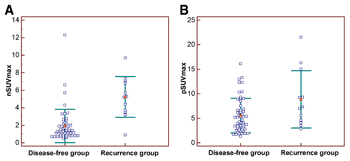Pretreatment PET Imaging of Lymph Nodes Predicts Recurrence in Breast Cancer Patients
By MedImaging International staff writers
Posted on 19 Sep 2012
Disease-free survival for invasive ductal breast cancer (IDC) patients may be simpler to predict with the help of F-18-fludeoxyglucose positron emission tomography (PET)/computed tomography (CT) imaging scans, according to new research.Posted on 19 Sep 2012
The study’s findings were reported in the September 2012 issue of the Journal of Nuclear Medicine, published by the Society of Nuclear Medicine and Molecular Imaging (Reston, VA, USA). New data revealed that high maximum standard uptake value (SUVmax) of F-18-FDG in the lymph nodes prior to treatment could be an independent indicator of disease recurrence.

Image: Comparison of SUVmax between disease-free and recurrence groups of IDC patients. (A) SUVmax of metastatic axillary LN (nSUVmax) was significantly higher in patients with disease recurrence than in patients who were disease-free (P < 0.001). Mean nodal SUVmax (1.9 in disease-free group and 5.2 in recurrence group) are indicated with orange boxes. (B) Primary-tumor SUVmax (pSUVmax) was significantly higher in patients with disease recurrence than in patients who were disease- free ( P= 0.0128). Mean primary-tumor SUVmax (5.5 in disease-free group and 8.9 in recurrence group) is indicated with orange boxes. Error bars represent SD. (Photo courtesy of the Journal of Nuclear Medicine).
“Many studies have revealed that breast cancer patients with axillary lymph node metastasis have a significantly poorer prognosis than those without nodal metastases,” noted Sang-Woo Lee, MD, PhD, from the department of nuclear medicine, Kyungpook National University Hospital (Daegu, Korea), and one of the authors of the study. “However, the prognostic value of F-18-FDG uptake in metastatic axillary lymph nodes with PET/CT has not been investigated in IDC patients,” he added.
In the study, researchers monitored 65 female patients with IDC who had undergone pretreatment F-18-FDG PET/CT and who had pathologically confirmed axillary lymph node involvement without distant metastases. Factors such as age, TNM (tumor, lymph node, and metastases) stage, estrogen receptor status, progesterone receptor status, human epidermal growth factor receptor 2 status, and SUVmax for the primary-tumor and axillary lymph nodes were analyzed. Patients underwent treatment and were followed for 21-57 months (median of 36 months).
Among the patients, 53 were disease-free and 12 had disease recurrence during the follow-up period. While both the primary-tumor and nodal SUVmax were higher in patients with recurrence, the nodal SUVmax was significantly higher. Moreover, compared to the other factors that were analyzed, only nodal SUVmax was found to be an independent determinant of disease-free survival. Using a receiver-operating-characteristic curve, the researchers demonstrated that a nodal SUVmax of 2.8 was the optimal cutoff for predicting disease-free survival.
“One of the important roles of molecular imaging in cancer research is to noninvasively predict precise prognosis. Our results showed significant improvement in the accuracy of risk prediction for disease-free survival rates when nodal SUVmax was added to well-known established risk factors,” stated Dr. Lee. “Our study suggests that 18F-FDG PET/CT could yield useful information for risk stratification and treatment strategies in IDC patients with axillary lymph node involvement.”
Related Links:
Kyungpook National University Hospital














